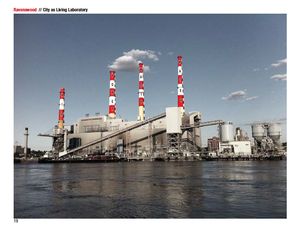by admin

An image of Big Allis from Mary Miss’ “If Only The City Could Speak.”
Courtesy Mary Miss
Event: The Civic Action Planning Model
Location: Center for Architecture, 04.12.12
Panelists: Lyn Rice, AIA, Partner, Rice+Lipka; Elliott Maltby, Principal, Thread Collective; Claire Weisz, AIA, Partner, WXY Archtecture + Urban Design
Moderator: Julie V. Iovine, Executive Editor, The Architect’s Newspaper and editor of the forthcoming Civic Action publication
Organizer:Center for Architecture; Noguchi Museum
”If Only The City Could Speak” is the name of the installation by artist Mary Miss and her project team, conceived as part of “Civic Action: A Vision for Long Island City,” which recently closed at the Noguchi Museum. This artist-led initiative, a collaboration between the Noguchi Museum and Socrates Sculpture Park—both situated in the area of study—illustrates that artists are one of the groups in the city that should not only speak, but take a leading role in the future of the built environment.
Isamu Noguchi (1904–1988) moved to the neighborhood—variously known as Ravenswood, Long Island City, or Astoria—in 1960, and seven years later fellow artist and sculptor Mark di Suvero moved there, too. Both artists shared a vision for their neighborhood. In 1985, Noguchi realized his by establishing a museum to exhibit his work. A year later, di Suvero founded Socrates Sculpture Park.
According to Jenny Dixon, director of the Noguchi Museum, who was in the audience, thanks to the visions of Noguchi and di Suvero, “Ravenswood is an important, international cultural destination. But more than that, it is also one of New York City’s few neighborhoods to remain a vital mix of art, industry, and residences. It is being redeveloped and more will follow with the new Roosevelt Island Cornell University/Technion development in close proximity.”
To that end, and in the spirit of Noguchi and di Suvero, the museum and park collaborated on a planning process with multidisciplinary design teams led by noted public artists Natalie Jeremijenko, Mary Miss, Rirkrit Tiravanija, and George Trakas to create different scenarios for the future of the neighborhood.
Panelist Elliot Maltby, an artist on Mary Miss’s team, described how the team explored the idea of establishing Ravenswood as a place of innovation, experimentation, and collaborative projects among artists and scientists who could address issues of social, economic, and environmental sustainability. Using the vertical elements of a local landmark—the smokestacks of Big Allis, a giant electric power generator—he said that “artists should get there before the project begins and should be the instigators, instead of being responsive to others.”
Claire Weisz, AIA, partner WXY Archtecture + Urban Design, and urban strategist for the project, concurred: “Artists have a role in leading and instigating…the wrong way to involve artists is to ask them to make products.”
Panelist Lyn Rice, AIA, partner at Rice+Lipka and participating Civic Action architect, agreed. He has worked on several collaborative projects with artists, most notably at Dia:Beacon, where Robert Irwin, an artist, landscape architect, and engineer, collaborated on the design and construction of the museum. In some cases, individual artists whose work would be exhibited were consulted. “All ‘creatives’ should get involved in the beginning and it is good to have equal voices together,” he said.
The second phase of the project will begin Sunday, 05.13.12, when the artists of Civic Action will take the exhibition of concepts, plans, and models that were at the museum, and translate them into physical realities with interactive public art projects at Socrates Sculpture Park. John Hatfield, executive director of Socrates, remarked, “An interesting and productive dialogue between artists, architects, urban planners, local community groups, and city officials on development plans for the Ravenswood area of Long Island City continues.”
Linda G. Miller is a contributing editor to Oculus and e-Oculus.

